Carbon, the stuff of many dream bikes, is a resource intensive material. To reduce the manufacturing effort and the poor carbon footprint of the black fibres, some manufacturers have started breaking new ground in carbon frame production. This could make carbon frames of the future better in almost every respect – but there are some hurdles in the way.
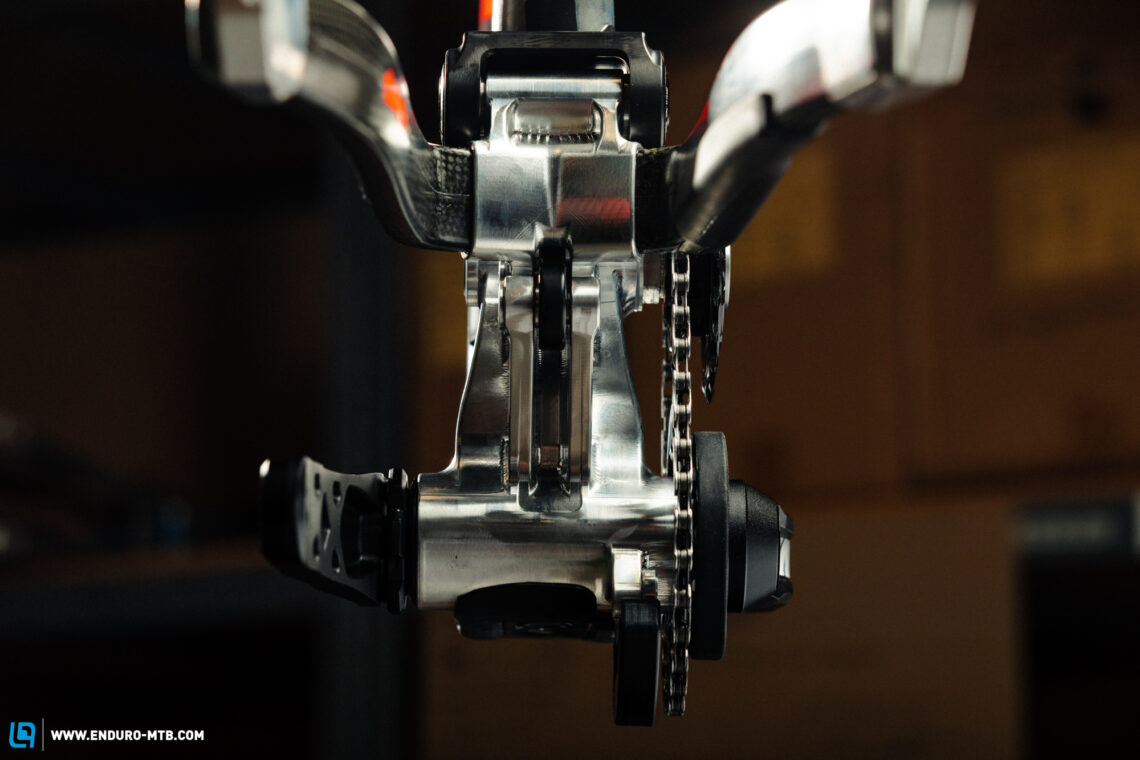
In the 1970s, some crazy fools came up with the idea of riding down the side of a mountain and haphazardly cobbled together steel-tubed beach cruisers to make “mountain bikes”. Fifty years later, almost everything about mountain bikes has changed. The off-road bicycle, initially reserved for a cockeyed fringe group in California, became the vehicle of a harsh extreme sports scene, and ultimately made its way into the garages of the civilised suburban settlements. Now, almost everyone owns a mountain bike. Once accepted by the masses, mountain bikes quickly proved to have enormous economic potential, which in turn fuelled a variety of developments – including new manufacturing processes.
In this article, we take an in depth look at the heart of every mountain bike: the frame. More precisely, how it’s made. If you see a bike these days and ask if it’s carbon, people might wonder if you’ve been living under a rock: you’ll find carbon on almost every modern bike component. However, there are a range of other materials that compete with black fibre, and not just as retro eye-catchers. Aluminium was always there, steel never quite died, and titanium will always be the exclusive oddball. But carbon is a permanent fixture in bicycle construction, and there’s a lot of technological innovation going on with black fibres, because the economic and environmental goals of the manufacturers have changed. Currently, the carbon of tomorrow’s bikes almost always comes from an oven somewhere in the Far East, but it could soon be created by robotic arms in Europe. Or, it might even undergo several recycling processes before becoming your mountain bike frame. At least that’s according to the visions of the brands and materials experts that we talked to. But what the hell do the bikes of two top international downhill racing teams have to do with it and is this how the mountain bike frames of the future will be built?
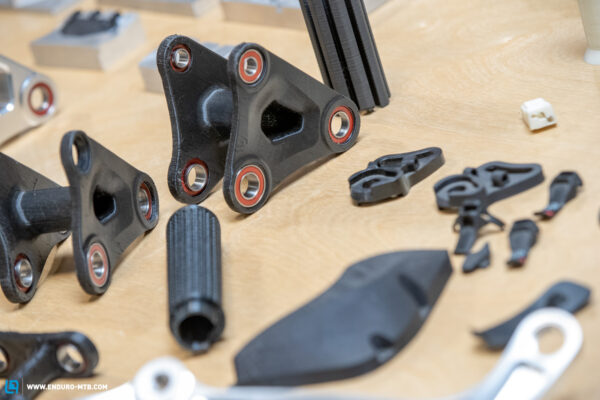
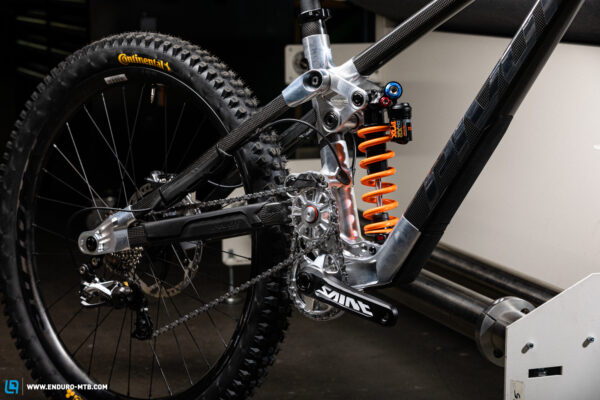
Mountain bike frame construction – Then and now
First, a quick sprint through history: early bike frames were usually made of steel. The retro racers rolling around in hip German neighbourhoods proudly display the logos of the top dogs of steel tubing to this day – Reynolds and Columbus. This early era of cycling is defined by straight steel tubing brazed together via steel lugs, some of which were very elaborately crafted. Then came the mountain bike. When Gary Fisher and the gang in Marin County, California first converted bikes for off-road use in the 1970s, they were also based on steel frames. In the 1980s, the first aluminium and carbon frames made it into production, for both road and mountain bikes. Aluminium frames also had straight tubes at first. It was only through hydroforming and CNC machining that curved tube shapes, variable wall thicknesses and complex connecting pieces, like linkages between the frame and shock, became possible. Manufacturers still use these techniques to build high-performance, aluminium bike frames today.
As a wholly new material, carbon frame construction went through several, sometimes outlandish concepts before finding any success. The frame of the first carbon MTB, the Lotus Sport hardtail, seemed heavily overbuilt and looked like a massive boomerang. It had nothing in common with the classic diamond frame shape of before. It was a different story in the road scene: Italian brand Colnago hit the jackpot in 1994 when they bonded straight carbon tubes to carbon lugs, retaining the diamond shape for their C40 road bike. Since then, carbon fibre has evolved into a proven and often coveted frame material for mountain bikes, thanks to a number of technical innovations.
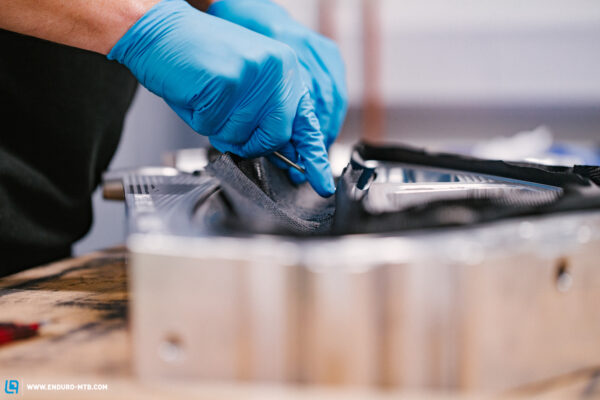
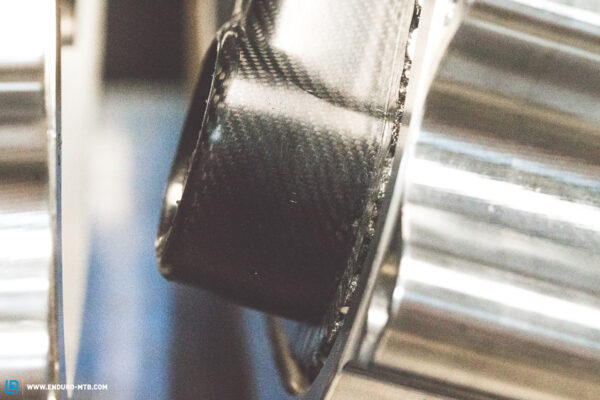
Today, most of our production bike frames rely on a monocoque construction. To this end, carbon fibre sheets, so-called prepregs, are cut to size and placed into an aluminium mould by hand until you’ve got the desired pattern for the frame, which is called layup. Think of it like two halves of an open Kinder Surprise chocolate egg. Using pressure and heat, these two halves are then bonded together and cured in the mould in large ovens, called autoclaves, creating the finished frame. Want more tech details? Gladly! In our comprehensive article on carbon myths, we delve even deeper into the production of aluminium and carbon components and even try to pick a winner among the two materials.
Thanks to sophisticated layups in the monocoque process, modern carbon frames and other carbon components can offer a wide variety of properties and last a long time when handled correctly. From super lightweight, to compliant, vibration-damping, and extremely robust, almost anything is possible if you’re willing to pay for it. So, it’s all good with the miraculous black fibres? Not entirely! The layups of carbon production require an enormous amount of manual labour, which is expensive (even in Asia). In addition, the monocoque design requires very expensive tools. Each component needs its own mould that’s machined from a solid block of aluminium, each of which can cost manufacturers as much as a mid-range car. This investment must pay off – and do so quickly. Want to make a few prototypes and see how the bike rides? Not that easy. Next year’s frame should have a steeper seat tube angle? Oops, then you’ll need a whole new mould! This hurts manufacturers. Therefore, the cost of manufacturing a carbon component the monocoque-way can only be justified when a certain quantity gets sold. And even then, the process is extremely energy-intensive, and pollutes the environment.The production of carbon emits about 30 kilograms of CO₂ per kilogram of material produced. Experts estimate that 10 to 30% of carbon becomes waste due to faulty production. In Germany alone, 870 tons of carbon waste is generated annually. Since there is still no effective recycling solution for carbon, the black fibres are currently piling up on dumps for hazardous waste. So, there are a lot of good reasons to question the production method of carbon frames – and maybe even reinvent it from scratch!

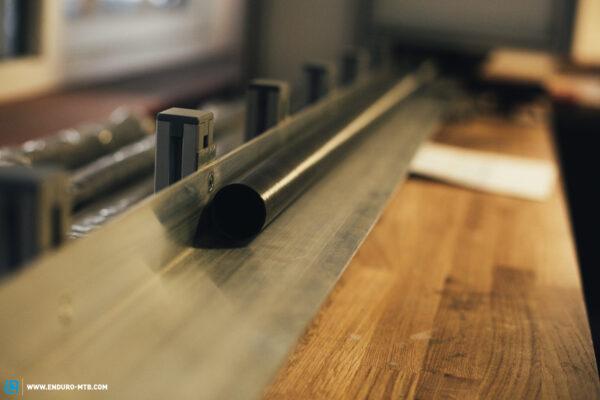
Carbon mountain bikes of the future – Green or gold?
More and more manufacturers are doing just that: rethinking and changing the way they’re producing carbon components. Some of them are well-known, while others are unknown pioneers or materials experts that want to partner with brands to show them the manufacturing methods of the future. But why not just keep working in the carbon factories of the bike world as usual? We asked a lot of questions and found that the reasons for the apparent abandonment of conventional monocoque carbon production methods aren’t the same for all brands. There are big differences in the individual goals that manufacturers are pursuing by changing their production technology – from green for sustainability to gold for profitability.
“The bicycle industry has kind of ‘gotten away with it’ when it comes to sustainability because everyone thinks of bicycles as ‘green’. But the impacts that [the bike industry is] producing are big.” – Spoon Custom Bikes
Lean production of mountain bikes in small batches
Let’s start with one extreme: downhill racing. The three siblings Rachel, Gee and Dan Atherton have been building their bikes bearing their family name since 2019, using carbon for their frames, but not a classic monocoque construction. Instead, the Welsh company bond straight carbon tubes to 3D-printed titanium lugs to make their frames.
Wait a second… Tubes bonded to lugs, as was the case with road bikes before the turn of the millennium? Yup, that’s right. But they’re exposed to completely different forces than road bikes on cobblestones and asphalt, aren’t they? Don’t worry, the Atherton Bikes manufacturing process has been proven in the prototype construction of both the aviation and Formula 1 industries. This is where another Welsh brand, Robot Bikes Co., comes in, which was incorporated into Atherton Bikes together with their many years of expertise using this bonding technology. The Athertons’ manufacturing process has nothing to do with retro nostalgia or references to classic road bikes. Instead, it allows the still relatively small MTB brand to keep its production lean and entirely based in the UK. This was clearly evident during our behind the scenes look at Atherton Bikes. Having monocoque moulds machined from aluminium takes a lot of time and money, requiring large batch production to be profitable. However, Atherton Bikes offer a wide range of sizes (up to 22 standard options) and also cater to custom wishes, building each frame to order. This is the opposite of large batch production – especially when Atherton Bikes are manufacturing frames for their professional downhill team, individually tailored to each of their riders.
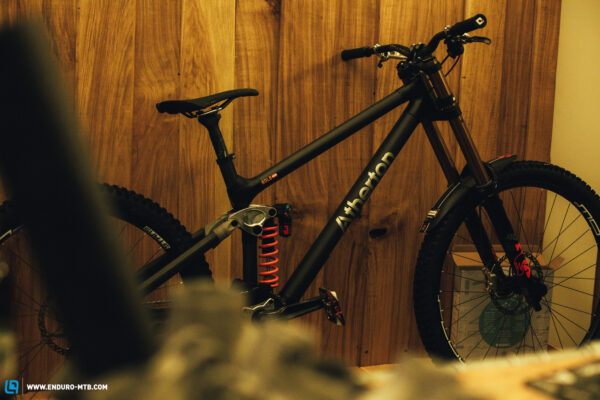
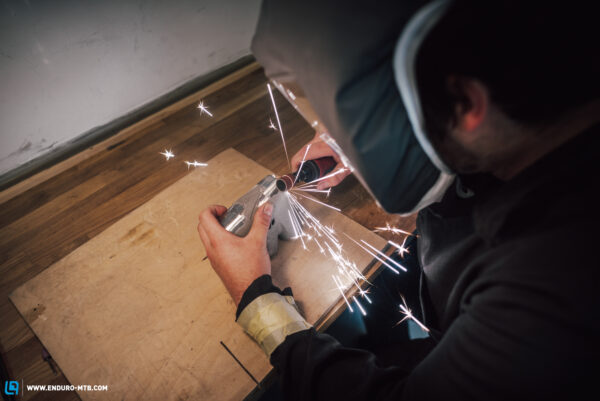
But Atherton Bikes also take this approach to production for sheer racing performance reasons. The straight and round tubes may look rudimentary, but their wall thickness is adapted to their respective location on the frame. They are cut off and processed in the required length during assembly, like goods sold by the metre. When 3D printing the titanium lugs, Atherton Bikes also see an advantage in using just as much material as the job requires – while always remaining flexible with their geometry. The design and angles of the lugs can be altered digitally via the 3D printer. Carbon tubes are cut to length as required. And voilà, you’ve got a new prototype, letting you test whether the frame offers the desired flex or not. This production method keeps production costs low compared to monocoque options despite producing modest quantities while also reducing material waste. At the same time, defects in the straight, uniform carbon tubes can be repaired very easily if necessary, which tends to be difficult on monocoque frames with complex and fragile geometries. This is another reason why their frames stand for durability, according to the Atherton’s. Sounds like a green tick for sustainability. But it also seems like a way to make carbon frame production profitable despite producing small quantities. Speaking of gold, Charlie Hatton and Andreas Kolb decorated themselves and their Atherton bikes with gold and silver at the 2023 UCI Downhill World Championship. Undoubtedly, the 3D-printed titanium lugs with the A on the head tube are up to the task. That said, we’ve already been able to confirm this when we put the Atherton AM.150 through its paces ourselves.
“As the drive for sustainability grows stronger every year, you’ll see increasing attention to new methods such as ours.” – Atherton Bikes

Monocoque MTB frames for mass production only
Other pro teams on the downhill circuit also see advantages in using this method. Although Pivot’s production frames rely on a monocoque construction, the downhill racing team lead by Bernard Kerr is relying on prototype bikes whose frames also consist of individual carbon tubes and lugs. Specialized are doing the same for their DH professionals. Their decision to go this route is also driven by the factors of time and flexibility. However, Chris Cocalis, head of Pivot Cycles, claims that there will be no way around the resource-intensive monocoque construction in the production of carbon frames in the future:
“If you have different goals, like Atherton, to produce a more truly custom product, then lugs make sense for small volumes. I’m sorry to say that there aren’t really a lot of great options in alternative carbon manufacturing processes that truly move the needle. Monocoque is the more efficient and optimised process and generally more cost efficient to produce in any kind of reasonable quantities.”–Chris Cocalis, Pivot
Pivot’s tube-and-lug technology serves as a rapid prototyping method for their professional racing team, but they have no ambitions to go into mass production with this method. Rather, Pivot’s goal is to bring the frames of the prototypes as close as possible to the monocoque production models in terms of the desired stiffness and flex, which will then eventually be available in stores. This means testing numerous layups for the carbon tubes, though in Arizona instead of Asia. According to Cocalis, using the lugged construction method for their prototypes is anything but a cost saver: including all the hours spent on machining and tinkering, one frame costs them about € 20,000.
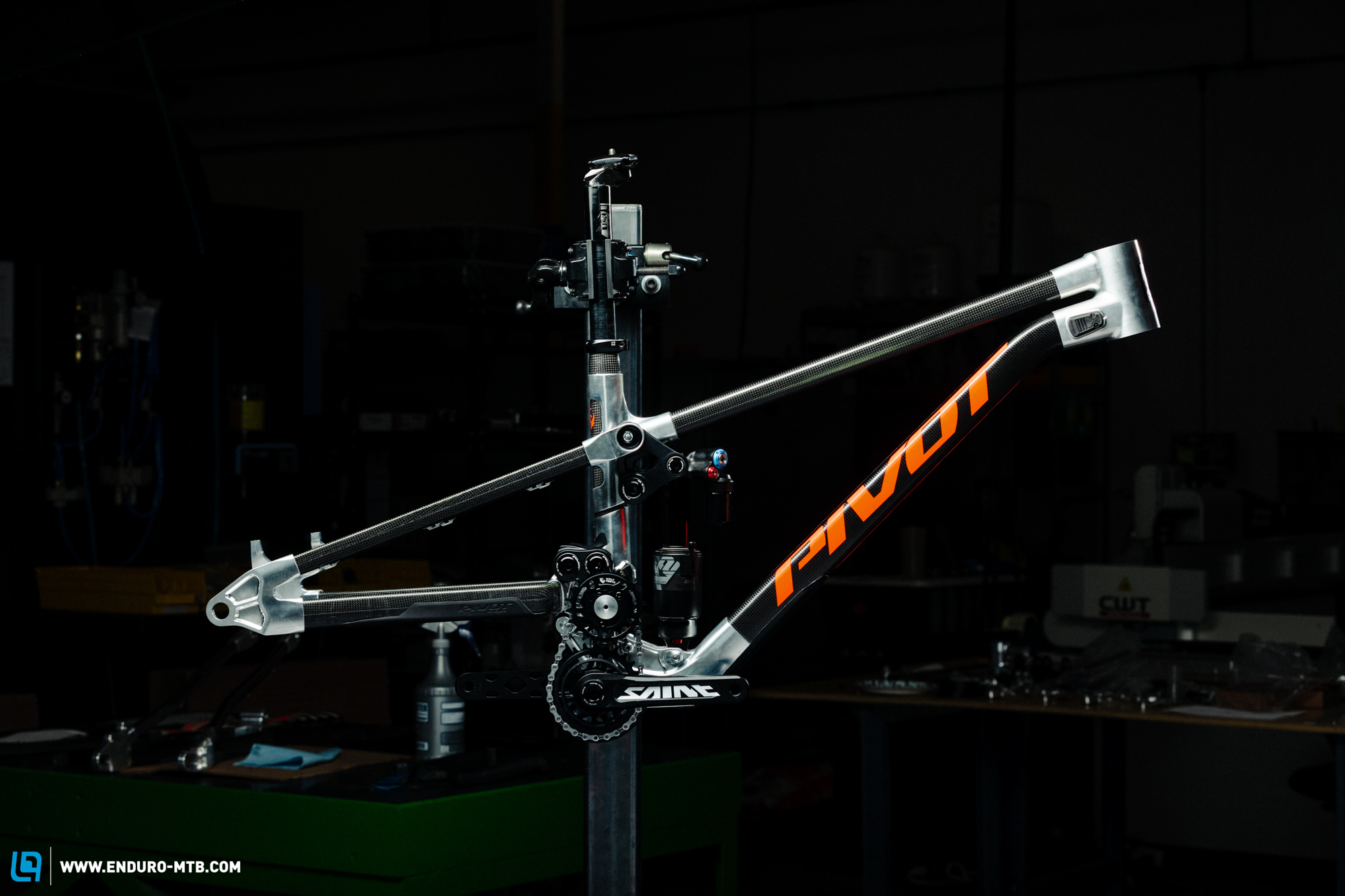
The racing teams’ reasoning is obvious: monocoque construction consumes too much time and resources to enable rapid prototyping in competitive sports. The tube-and-lug method offers many advantages in these kinds of scenarios. It’s not just professional racing teams that resort to tube-and-lug construction: the Canadian development service providers Faction Bike Studio use a similar method, allowing them to get prototypes on the trails a whole lot quicker. Whether this method is then retained for production, as in the case of Atherton Bikes, or ultimately replaced by a monocoque design, as in the case of Pivot, is a question of production quantity and company philosophy.
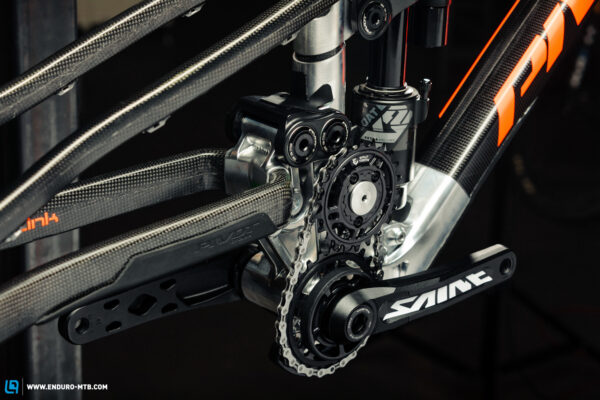
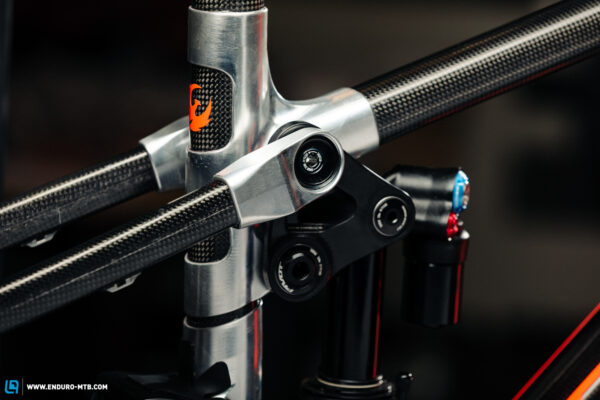
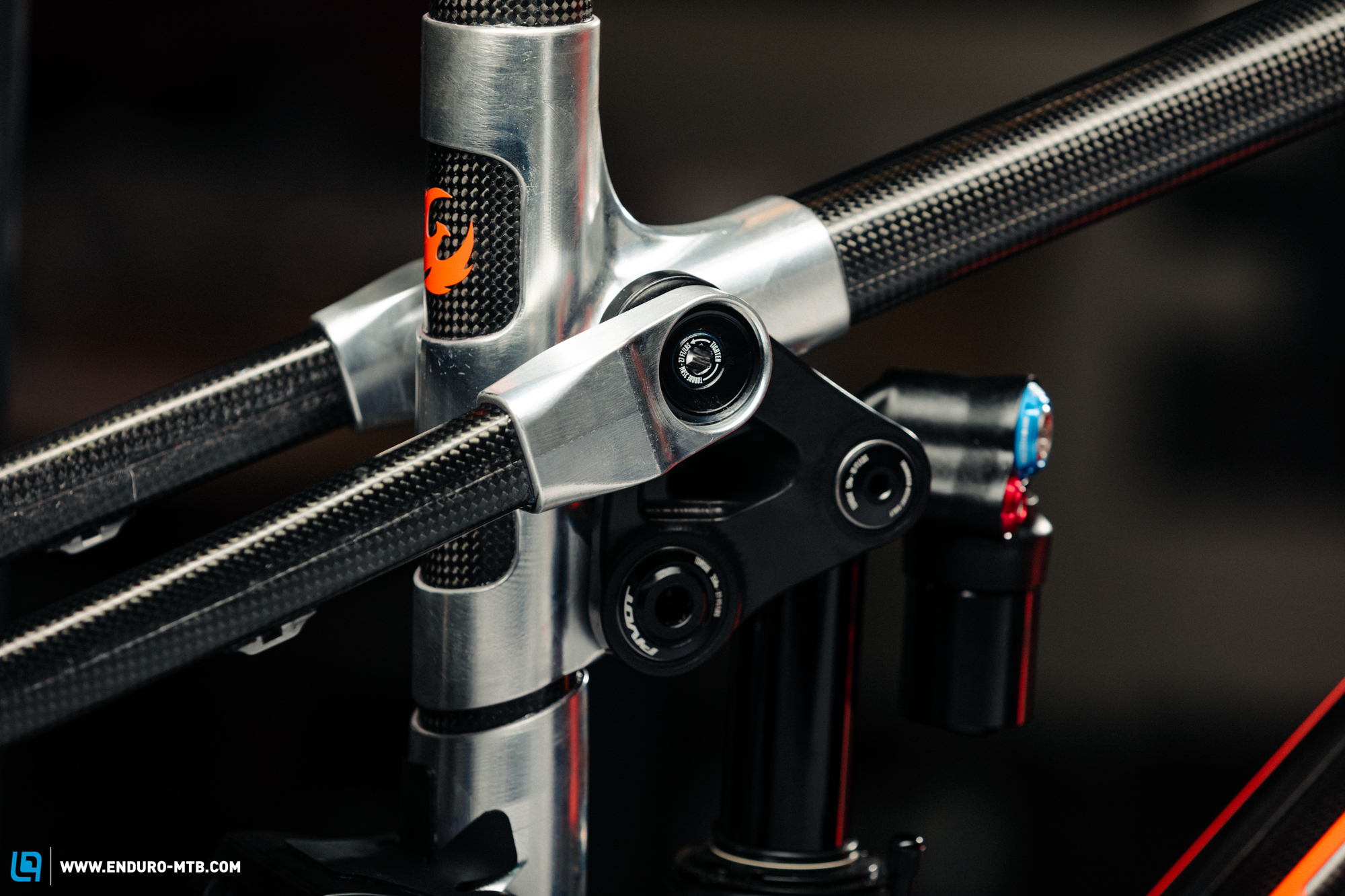
Green ideas from third-party suppliers in the MTB industry
Granted, a few pro downhill teams don’t represent an accurate reflection of the entire MTB industry. To identify the general direction that the future production of carbon frames could take, it’s more interesting to look at approaches that aren’t just aimed at a small group of racers, but rather at everyday folks like us. The matter of producing frames has never been reserved for the bicycle brands themselves. The know-how, machines, and processes available from suppliers in the Far East are important factors for most bike companies to consider when asking what’s technically achievable. Currently, there are a number of new players, previously unknown in the bike industry, that are positioning themselves to have a say in the carbon production of tomorrow.
Eco fibres in the carbon composites of mountain bike frames
SCALE is a third-party supplier from France, not directly involved in bicycle production themselves. The French materials experts are looking for partnerships with manufacturers who want to make their carbon products more climate-friendly. In doing so, they continue using the tried and trusted monocoque construction. However, depending on the functional requirements, up to 50% of the carbon can be replaced by SCALE’s special eco fibres, thereby improving the overall environmental footprint of the finished component. According to the start-up, there are no compromises in quality to be expected. On the contrary, the high torsional stiffness of their material, which is visually reminiscent of lightly coloured animal hairs, can actually increase the performance of the end product when implemented correctly. However, classic carbon fibres will still be necessary to provide sufficient tensile strength in the component, because their eco fibres perform lower in this regard. As such, SCALE’s eco fibres can’t replace the resource-intensive black fibres entirely. The whole thing still needs to be cured in an epoxy resin, too. Overall, their technology can reduce CO₂ emissions by a considerable 40%, since the eco fibres are produced in a climate-friendly manner, according to SCALE. The French company are currently in talks with several bicycle brands hoping to use their know-how to make greener carbon mountain bikes.

Ready in minutes, and with a long shelf-life
What sounds like a mediocre lunch are actually two core arguments for Revved’s approach to carbon production. For manufacturing carbon components, the American brand requires moulds indistinguishable from the proven monocoque process. However, there’s a big difference in the ingredients: they are thermoplastic instead of thermoset. Thermosetting carbon is a one-way production process. The processed fibres – whether eco or carbon fibres – cannot be separated from the epoxy resin in which they are cured. The carbon components currently found on our bikes are almost always thermoset. In the event of damage or at the end of the product life cycle, they’re nothing but hazardous waste. Thermoplastic carbon, on the other hand, also consists of carbon fibres, but these aren’t soaked in an epoxy resin, instead, an alternative binder is used that can be liquefied again when heated. Therefore, the fibres in thermoplastic carbon can be extracted by heating the component, theoretically allowing you to reuse them. Revved produce thermoplastic carbon in the US and they’ve already partnered with Guerrilla Gravity to manufacture their US made carbon frames. According to Revved, this approach offers many advantages – ecologically, economically, and on the trail.
“Thermoplastic carbon material and manufacturing processes are absolutely a better alternative from a sustainability aspect.” – Rob Wesson, Revved Carbon
Rolls of conventional, thermosetting resin infused carbon must be cooled continuously before they reach the work bench where they’re cut and hand-laid into moulds. And even with strict climate control, they only last about six months. Thermoplastic carbon, on the other hand, does not require cooling during storage and has an unlimited shelf life. Once placed in a mould, thermosetting carbon requires several hours of heat and pressure in the autoclave to cure. Thermoplastic carbon, on the other hand, only takes minutes in the hot press to become a finished component. The energy and resource saving potential of thermoplastic carbon seems significant. But does it offer any benefits on the trail? And is it more expensive?
To the first question, Revved and Guerrilla Gravity, which are the first and only bicycle brands currently using this new material to produce their frames, have a clear answer: Revved carbon is three times as impact-resistant as conventional carbon fibre products. Bam! With this, they hit carbon right on its Achilles heel, which is an aspect that still frightens off some sceptics, because of its vulnerability to impacts. While being more impact resistant, Revved carbon has similar stiffness and weight values as standard thermoset carbon. Okay. But what about the price? Mountain bikes are expensive toys, we know that. However, the bikes from Guerrilla Gravity seem to be roughly comparable in price to many other brands out there.
The challenge Revved faces in finding other manufacturers to partner with is the necessary commitment on the part of the brands:
“if an alternative material/process doesn’t easily and immediately make their current product/model lighter, faster, stronger, and less expensive, then the interest to move forward starts to wane.”
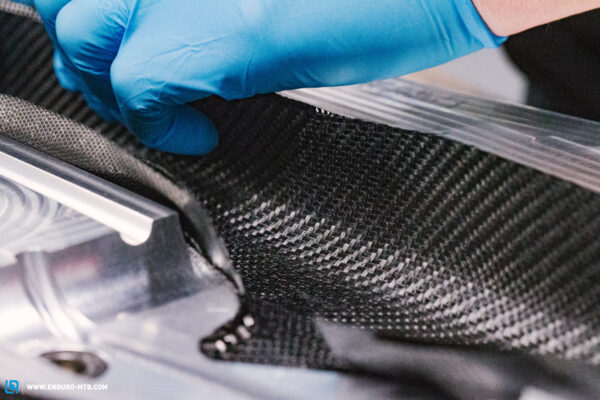
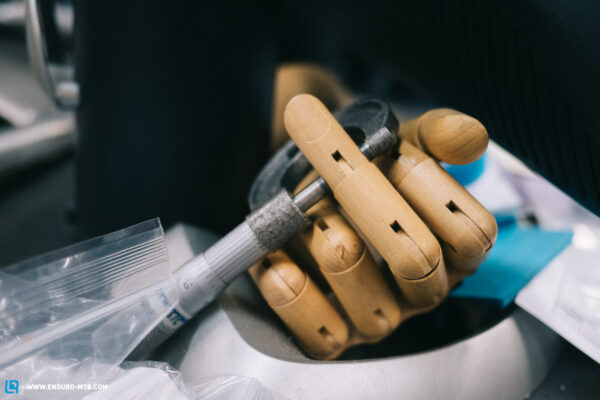

One mountain bike frame per minute
Fibertech Bike Technology, or Fi.Bi.TEC, take adifferent approach. The German company are rooted in the automotive industry and manufacture bicycle frames using a method that is already a proven standard for cars. They use thermoplastics and carbon, but without the need for carbon prepregs, laying patterns, or an oven. At Fi.Bi.TEC, the carbon fibres come in the form of a granulate that can be used in injection moulding. By adding reinforcements in critical regions, they can model the properties of the frames with a high level of precision. The advantages of the process are a 100% reduction of production waste, automotive quality standards, and an impressive production speed: Fi.Bi.TEC can stamp out a new frame in just one minute! That’s less than you need to choose the colour of the paint job. Fi.Bi.TEC themselves claim that this process has the potential of cutting CO₂ emissions by a whopping 80% compared to other common methods.
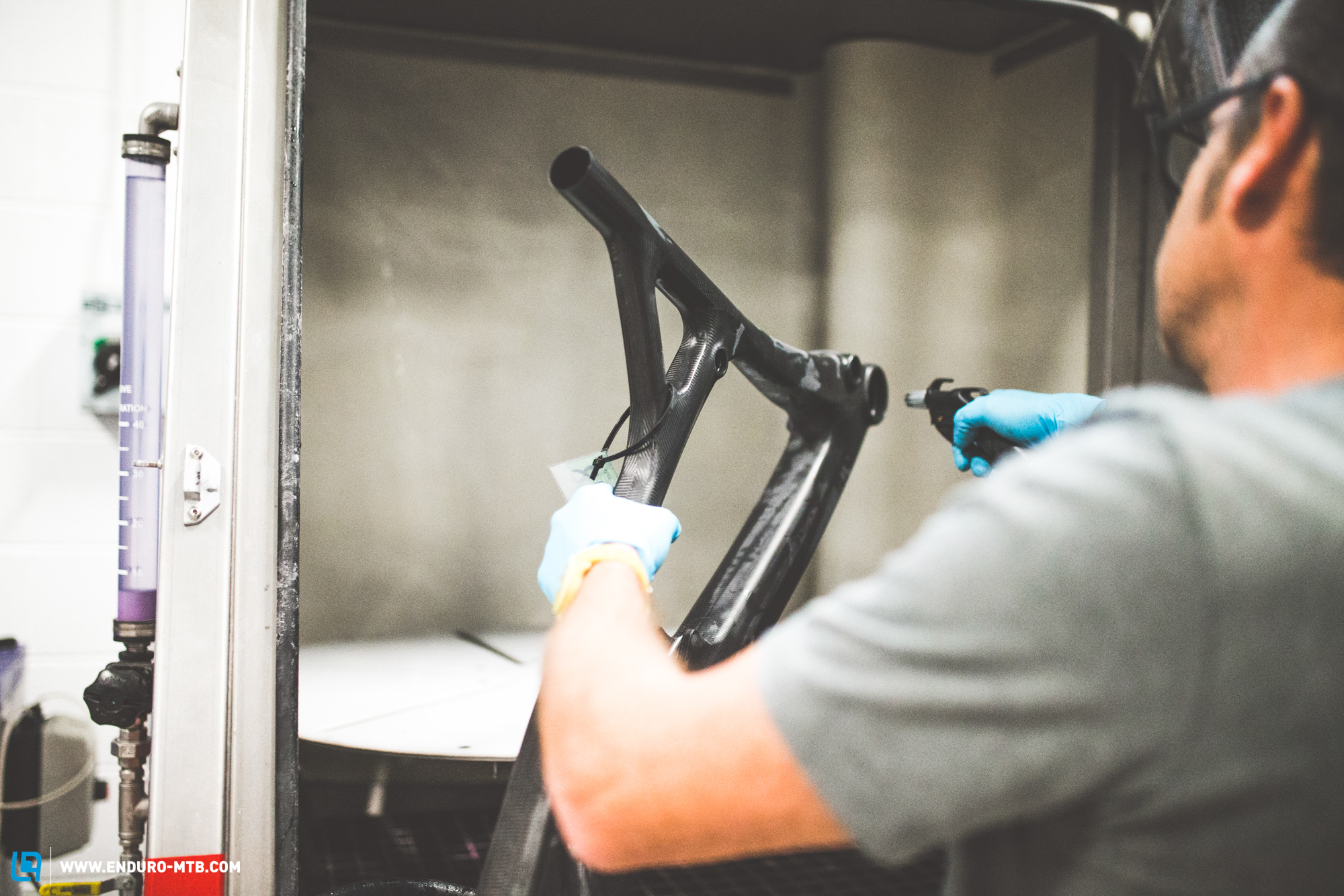
What’s stopping the carbon frames of the future?
So, we’ve established that alternative production methods for carbon frames that do away with elaborate monocoque moulds, manual lay-ups, and energy-intensive baking in an autoclave already exist. And they can win medals, too. Innovators like Revved Carbon, SCALE, and Fi.Bi.TEC already have the know-how needed for resource-efficient carbon production, which also provides tangible advantages such as increased impact resistance. Lugged carbon tubes, in particular, have proven their potential when it comes to making quick adjustments in professional downhill racing or prototyping. However, this production method is mainly suitable for small batches or one-off custom builds. You’ll be lucky to spot an alternatively manufactured carbon frame on the trails and in bike park queues. Why is that, and when will that change?
Shaky recycling promises from bike manufacturers
The oft-touted trump card of thermoplastic carbon components is their recyclability and thus sustainability. At the current technological state, however, it should be referred to as downcycling instead of recycling. Revved Carbon can crush off-cuts of their material and then continue to use it for smaller components or in injection moulding. A concrete example of downcycling is provided by the bike manufacturers FORGE+BOND. The American brand use thermoplastic carbon for the production of their rims. They reshape defective products or production waste to let it live on – as tire levers. Although this isn’t quite true recycling. Future technological attempts to reuse thermoplastic carbon could give these materials a powerful boost in the coming years. Due to new collaborations and growing interest from the industry, a defective carbon frame might actually become a new frame in the future, not just a tire lever.
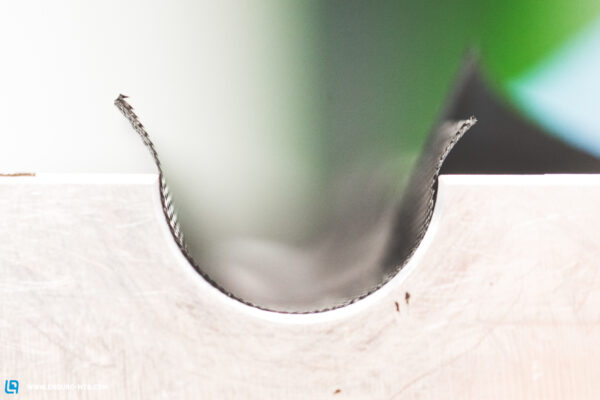
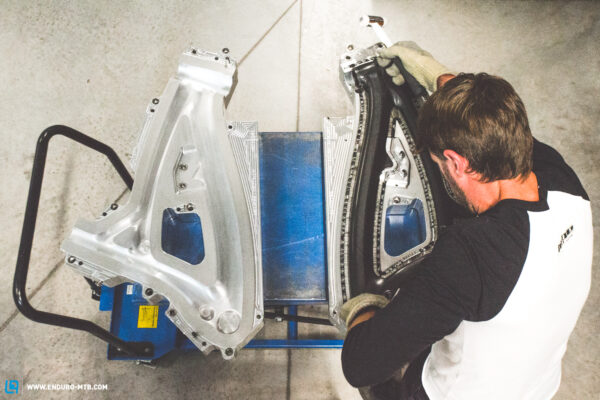
A rethinking is needed among MTB frame manufacturers
The success of alternative carbon products on the mass market depends largely on the willingness of bike brands to engage in alternative processes. Materials experts have already determined that novel production methods of carbon frames are economically viable for manufacturers. So why are there so few brands with alternative approaches, like Guerrilla Gravity in cooperation with Revved Carbon? Part of the answer is that the new methods cannot be seamlessly integrated into bicycle manufacturers’ existing structures. You cannot simply place Revved Carbon in a conventional monocoque mould and follow the exact same production process. Moreover, even the construction of the frame must be geared to the new material in order to make the most of its properties. Many brands have their carbon frames manufactured in large factories in the Far East, sharing their production capacity with other brands. A single client pushing to convert the entire production line to cater to a new material and production process is unlikely to find much success as long as the competitors don’t also at least show interest in a move away from classic, thermosetting carbon. The only options remaining are for brands to switch production partners, go for more local production, or bring production in-house. All this comes with complex strategy changes, uncertainties, and capital investments. Therefore, despite potential opportunities, the switch to a new manufacturing process often gets nipped in the bud before it can take off.
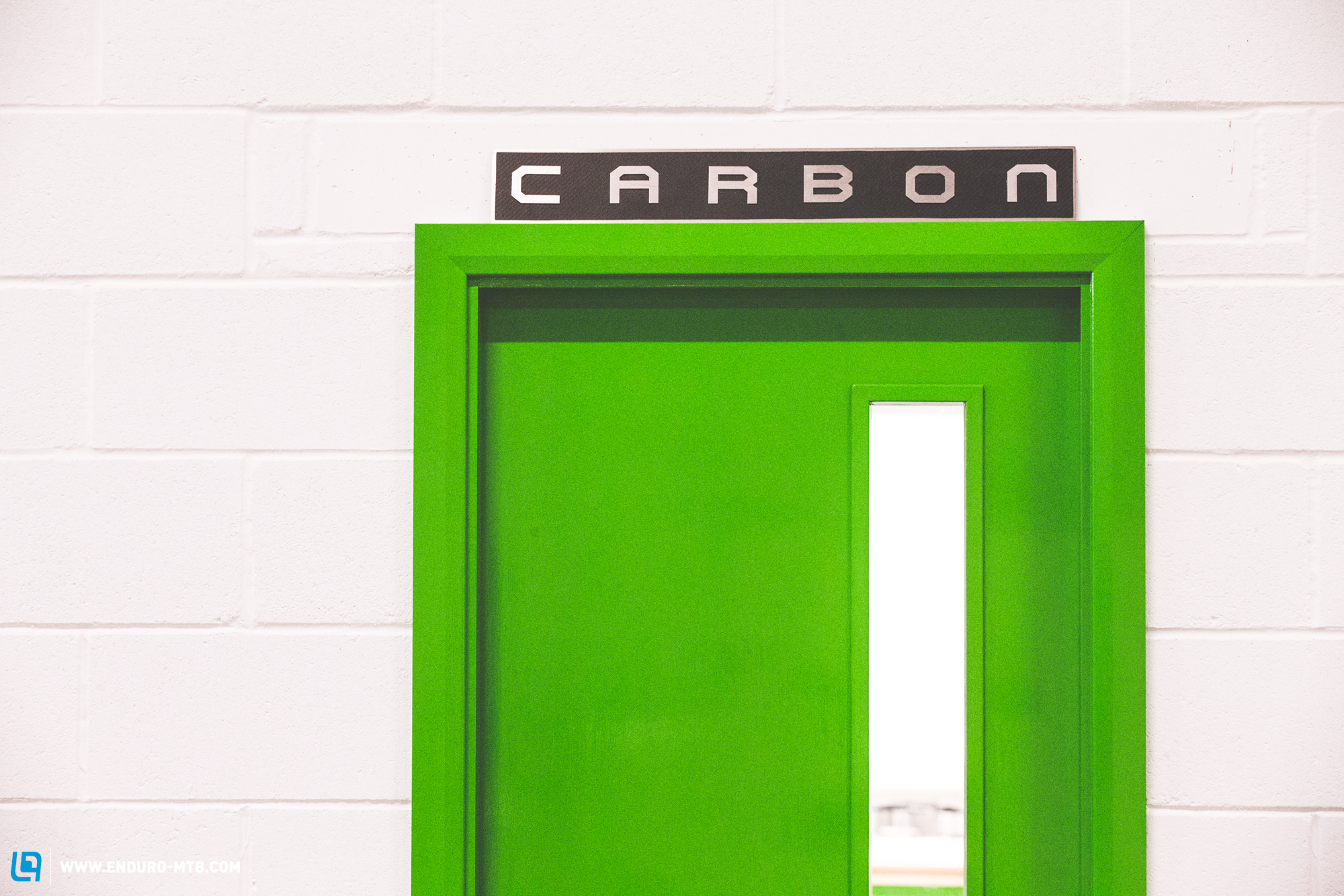
Sustainability as standard – Also for mountain biking
“This carbon frame is sustainably produced” is something we love to see, but as long as the marketing teams feel that the addition of “but it performs well, nonetheless!” is a required part of the sales spiel to get customers excited about resource-saving and recyclable products, they will have a hard time gaining momentum. If, on the other hand, the demand for bicycles that aren’t just high-performing, but also ecologically sustainable grows, we’ll quickly see new approaches and attitudes sprout up. Until then, we as consumers will be faced with the task of seeing through the greenwashing and being deliberate in our choices, with a view to quality and longevity instead of supposed bargains.
Alternatively produced carbon is in the starting blocks. It can be greener, economical, and very high-performing. Its uses range from affordable small-batch production, which has already proven itself in the Downhill World Cup circuit, to fully automated mass production, which is how your next bike could be made. But all these new carbon manufacturing processes still require feasible recycling solutions and commitment – from brands as well as customers – to really make a breakthrough in the bike industry.
Did you enjoy this article? If so, we would be stoked if you decide to support us with a monthly contribution. By becoming a supporter of ENDURO, you will help secure a sustainable future for high-quality mountain bike journalism. Click here to learn more.
Words: Moritz Geisreiter Photos: Divers









